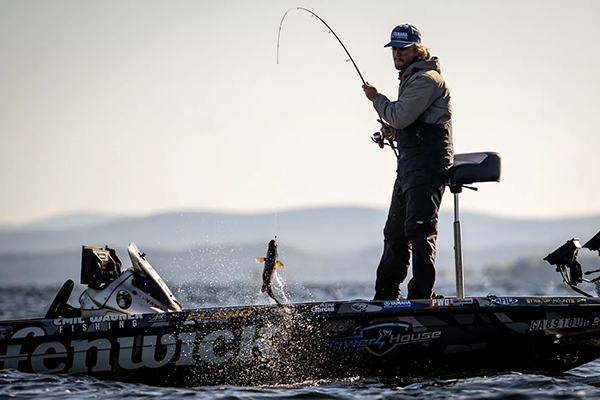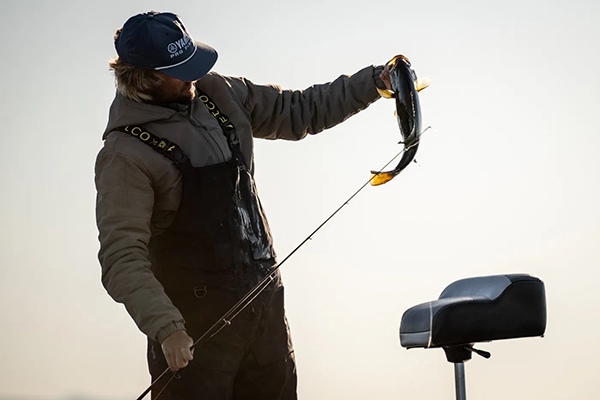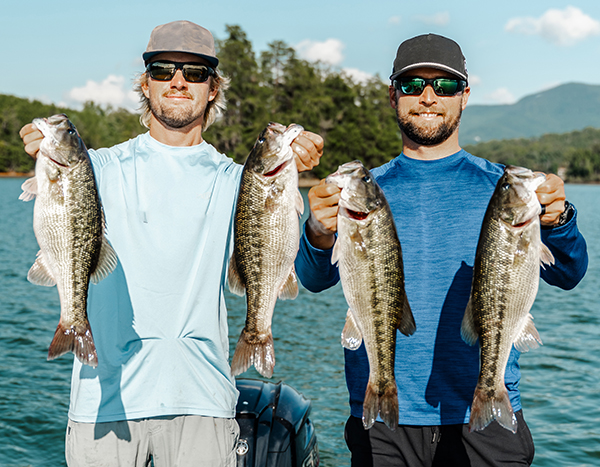For many the month of October prompts thoughts of pumpkin patches, autumn foliage, and Halloween celebrations but for Yamaha Outboards pro Emil Wagner, October is an excellent time to be on the water chasing fish.
When he’s not competing on the Bassmaster® Elite Series, Wagner is a full-time fishing guide on Lake Lanier and surrounding fisheries. Like clockwork, each October he notices fewer vehicles parked at boat ramps and less people on the lake. This isn’t because the fishing turns poor in the fall, but rather due to people’s attention turning towards football or hunting seasons this time of year.

While Wagner enjoys a game day as much as anyone, he also knows October offers some incredible fishing opportunities for anglers looking for the next bite.
Lakes Turning Over in October
“Turnover” is one of the first things that comes to mind for Wagner when he thinks of October fishing, whether he is targeting bass or another species. Lakes turnover when the surface water cools and becomes denser than the rest of the water column, causing it to sink. This causes a substantial mixture, which leads to changing oxygen levels and water quality throughout a body of water.
This process happens across the country but for Wagner’s region of Georgia and the Carolinas, this turnover almost always comes in October.
“I mostly fish herring fisheries like Lake Lanier, Hartwell, Clarks Hill or Lake Murray,” Wagner said. “In my area, fall turnover usually results in dirty water. The water starts to turn in the shallower, upper ends of the lake and then works its way down to the dam.”
Dirty, brownish water or an unpleasant smell is a telltale sign that a lake is experiencing turnover. But Wagner says to not be discouraged. Instead, change your bait color or profile to match the dingy water. When faced with this scenario Wagner often leans on bright, contrasting colors like chartreuse, bone white, bright orange, or even pink.

Class is in for Schooling fish
For many bass aficionados, fall fishing is synonymous with schools of fish feeding aggressively on baitfish at or near the surface. The schooling bite, as Wagner refers to it, can be very visible with blow-ups, chasing fish, or nervous water from fleeing baitfish.
“The schooling bite is absolutely my favorite way to catch them in the region I fish in the month of October,” Wagner said. “The schooling bite is a great way to catch bass in the fall, but you are liable to catch white bass, hybrids and striped bass with this pattern, too. These predatory fish will setup on ambush locations, oftentimes a main lake point or underwater hump, and when a group of baitfish swim by it can ignite a feeding frenzy!”
Find yourself amidst this action and you will be in for a fish-catching bonanza, but this scenario doesn’t play out the same in every area of a fishery. If Wagner is not seeing the activity he’s looking for, he will get behind the console of his Phoenix boat, fire up his 250-horsepower V MAX SHO® and drive around the lake at 30 to 45mph to search out productive areas.
Wagner looks for surface activity, feeding birds, or areas with an overabundance of baitfish. Fall fishing can often be feast or famine. When you’re in an area that’s not productive, don’t overthink it in October. Fire up your outboard, move to another area and continue to cover water.
“Groups of fish are much larger in October and the rest of fall than other times of year,” Wagner explained. “In the spring and summertime, I find a lot of ten, twenty, or maybe thirty fish groups. But in the fall, it’s routine to find schools of fish with hundreds of fish grouped together. Fishing can be tough when you’re not around these mega-schools, but it can turn on in a hurry when you do find them.”
When Wagner finds the action, he is looking for, he’ll use walking topwater baits, buzzbaits or a Berkley Choppo, small swimbaits or flukes to mimic the small baitfish bass and other predatory fish are keyed into.

Bait Selection – Really Big or Super Small
When it comes to choosing which lures to use in the months of October and November, Wagner opts for one extreme or the other. Shad, herring and other species of baitfish become primary forage in the fall, and they are often very small in the month of October.
“I want to show fall bass something really large and aggressive, or I’ll be on the opposite end of the spectrum and use something extremely small and finessy,” Wagner explained. “I either want to match the profile of the smaller-sized baitfish they are feeding on or show the fish something big and out of place, completely different than what they are used to seeing.”
Emil rotates between micro-offerings like a 2.5-inch swimbait or a junior sized Fluke style lure and oversized topwaters or hard-body swimbaits. He’ll cover water with these loud, disruptive offerings in hopes to ignite a reaction strike. Wagner’s one-two punch helps to sample the mood of the fish each day on the water and helps him key into what the fish want.
October fishing has its nuances, but it can be a fantastic time to be on the water. Take Wagner’s tips to the lake with you and enjoy some good fishing away from the crowds this fall.
Back to Blue Life
When he’s not competing on the Bassmaster® Elite Series, Wagner is a full-time fishing guide on Lake Lanier and surrounding fisheries. Like clockwork, each October he notices fewer vehicles parked at boat ramps and less people on the lake. This isn’t because the fishing turns poor in the fall, but rather due to people’s attention turning towards football or hunting seasons this time of year.

While Wagner enjoys a game day as much as anyone, he also knows October offers some incredible fishing opportunities for anglers looking for the next bite.
Lakes Turning Over in October
“Turnover” is one of the first things that comes to mind for Wagner when he thinks of October fishing, whether he is targeting bass or another species. Lakes turnover when the surface water cools and becomes denser than the rest of the water column, causing it to sink. This causes a substantial mixture, which leads to changing oxygen levels and water quality throughout a body of water.
This process happens across the country but for Wagner’s region of Georgia and the Carolinas, this turnover almost always comes in October.
“I mostly fish herring fisheries like Lake Lanier, Hartwell, Clarks Hill or Lake Murray,” Wagner said. “In my area, fall turnover usually results in dirty water. The water starts to turn in the shallower, upper ends of the lake and then works its way down to the dam.”
Dirty, brownish water or an unpleasant smell is a telltale sign that a lake is experiencing turnover. But Wagner says to not be discouraged. Instead, change your bait color or profile to match the dingy water. When faced with this scenario Wagner often leans on bright, contrasting colors like chartreuse, bone white, bright orange, or even pink.

Class is in for Schooling fish
For many bass aficionados, fall fishing is synonymous with schools of fish feeding aggressively on baitfish at or near the surface. The schooling bite, as Wagner refers to it, can be very visible with blow-ups, chasing fish, or nervous water from fleeing baitfish.
“The schooling bite is absolutely my favorite way to catch them in the region I fish in the month of October,” Wagner said. “The schooling bite is a great way to catch bass in the fall, but you are liable to catch white bass, hybrids and striped bass with this pattern, too. These predatory fish will setup on ambush locations, oftentimes a main lake point or underwater hump, and when a group of baitfish swim by it can ignite a feeding frenzy!”
Find yourself amidst this action and you will be in for a fish-catching bonanza, but this scenario doesn’t play out the same in every area of a fishery. If Wagner is not seeing the activity he’s looking for, he will get behind the console of his Phoenix boat, fire up his 250-horsepower V MAX SHO® and drive around the lake at 30 to 45mph to search out productive areas.
Wagner looks for surface activity, feeding birds, or areas with an overabundance of baitfish. Fall fishing can often be feast or famine. When you’re in an area that’s not productive, don’t overthink it in October. Fire up your outboard, move to another area and continue to cover water.
“Groups of fish are much larger in October and the rest of fall than other times of year,” Wagner explained. “In the spring and summertime, I find a lot of ten, twenty, or maybe thirty fish groups. But in the fall, it’s routine to find schools of fish with hundreds of fish grouped together. Fishing can be tough when you’re not around these mega-schools, but it can turn on in a hurry when you do find them.”
When Wagner finds the action, he is looking for, he’ll use walking topwater baits, buzzbaits or a Berkley Choppo, small swimbaits or flukes to mimic the small baitfish bass and other predatory fish are keyed into.

Bait Selection – Really Big or Super Small
When it comes to choosing which lures to use in the months of October and November, Wagner opts for one extreme or the other. Shad, herring and other species of baitfish become primary forage in the fall, and they are often very small in the month of October.
“I want to show fall bass something really large and aggressive, or I’ll be on the opposite end of the spectrum and use something extremely small and finessy,” Wagner explained. “I either want to match the profile of the smaller-sized baitfish they are feeding on or show the fish something big and out of place, completely different than what they are used to seeing.”
Emil rotates between micro-offerings like a 2.5-inch swimbait or a junior sized Fluke style lure and oversized topwaters or hard-body swimbaits. He’ll cover water with these loud, disruptive offerings in hopes to ignite a reaction strike. Wagner’s one-two punch helps to sample the mood of the fish each day on the water and helps him key into what the fish want.
October fishing has its nuances, but it can be a fantastic time to be on the water. Take Wagner’s tips to the lake with you and enjoy some good fishing away from the crowds this fall.
Back to Blue Life
